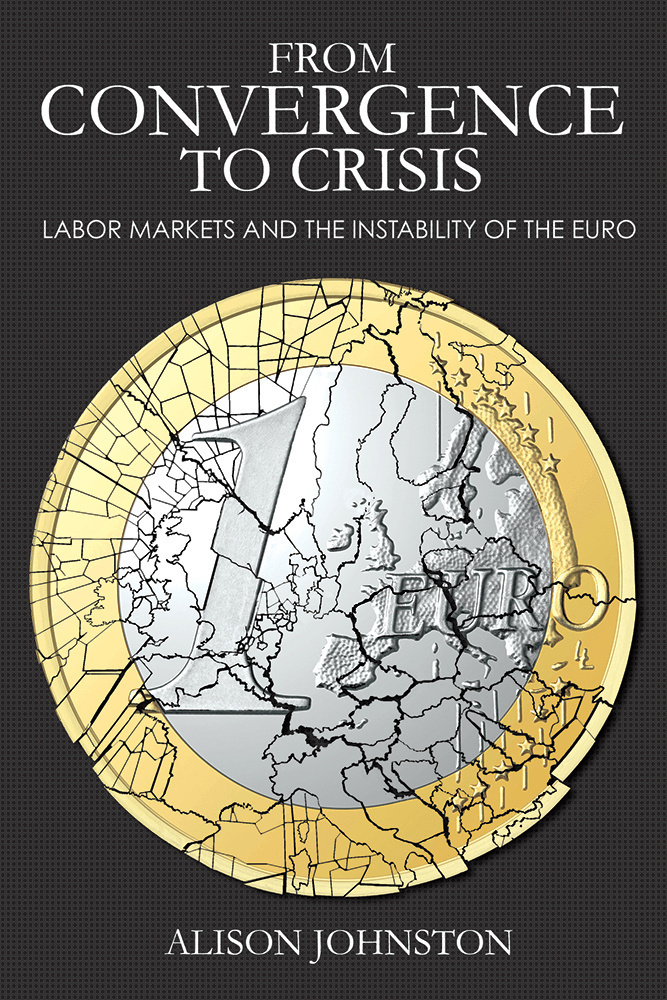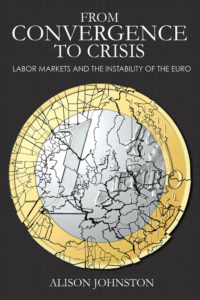
From Convergence to Crisis: Labor Markets and the Instability of the Euro by Alison Johnston
 This is part of our special feature on The Crisis of European Integration.
This is part of our special feature on The Crisis of European Integration.
Since the onset of the euro crisis, economists have consistently pointed towards the inability of countries in the Eurozone periphery[i] to effectively moderate wages as an imperative area for reform. Some even go so far as to claim this as the main cause of economic crisis in these countries. As Alison Johnston points out in her debut book, rising labor unit costs were indeed a defining characteristic of these member states in the early years of the Euro; most importantly in sectors such as public services or construction that are sheltered from trade. Yet she goes further and asks: what if euro adoption itself has made it increasingly difficult for these countries to achieve wage moderation? Exploring this question, Johnston’s book traces the development of wage rate bargaining institutions over time and across member states of the European Economic and Monetary Union (EMU). Her argument is as intuitive as it is compelling. More specifically, she zooms in on the trade-sheltered sectors of these countries; sectors infamous for sticky wages and low competitiveness gains. The (in-)ability of these sectors to moderate wage inflation, Johnston argues, has directly impacted national inflation and price competitiveness outcomes before as well as after the introduction of the common currency.
In Johnston’s account, Maastricht criteria as well as national central banks, effectively drove down price inflation in EMU member states prior to the adoption of the euro. The interplay of these institutions forms the basis of Johnston’s argument. Whilst, Maastricht criteria enforced credible limits on public spending, inflation- and interest rates, national central banks pursued non-accommodating and country-specific monetary policy in order to uphold these criteria. This institutional setting, highly conducive to enforcing wage moderation, was radically altered after the introduction of the common currency in 1999. As national monetary powers became the domain of the European Central Bank, the entire euro zone became subject to only one interest rate. Not surprisingly, this “one-size-fits-all” interest rate was too low for countries experiencing rapid growth, such as those in the Eurozone periphery, whilst simultaneously too high for countries in the Eurozone core that were suffering from capital outflows in the early years of the euro. Absent central bank discipline to enforce wage compression and without the incentive of euro zone membership to drive home the rules of the Stability and Growth Pact – the lethargic sequel of the Maastricht criteria – member states in the Eurozone periphery grew unable to suppress inflationary pressures, propelled by their domestic trade-sheltered sectors. The story looked very different in EMU core countries that, unlike their neighbors in the periphery, were in possession of alternative institutional arrangements to achieve wage rate moderation: namely coordinated wage rate bargaining structures that reduced the negotiating position of trade-sheltered sectors and enforced cross-sectoral wage rate compression. As such, euro adoption itself put the periphery at a comparative disadvantage. Unable to suppress wages, inflationary bubbles developed in these member states, ultimately leading to the onset of crisis.
Now, scholars of the euro crisis may well contend that the asymmetric effects of a singular monetary policy on wage inflation have been established well before the arrival of this book (somewhat ironically in retrospect, Robert Mundell received a Nobel prize for his work on this topic in 1999: the very year the euro was introduced). Even more importantly, scholars before Johnston, especially those researching Varieties of Capitalism (VoC), have discussed the interaction between national central banking and wage bargaining institutions throughout the lifespan of the euro (See e.g. Hall & Franzese, 1998 or Hancké, 2013). So why exactly should one read Johnston’s book? The answer to this is alluded to in the book’s subheading; namely Johnston’s elaborate work on disentangling the mechanisms that drive inflationary pressures in European labor markets. Of course Johnston’s close ties to the VoC sphere shines heavily through the pages of her debut book. Yet, she departs heavily from the classic VoC framework in analyzing how institutional change has affected different forms of capitalism within the Eurozone. This too is one of the main benefits of Johnston’s story. In moving away from the typically over-emphasized inertia of institutions and instead of exploring the effects of institutional change, her book feels innovative and refreshingly up-to-date.
Overall, Johnston’s book makes multiple, substantial contributions to the scholarly work on the euro crisis. In chapter one, she justifies and describes her argument, doing an excellent job of surveying the euro crisis literature as well as positioning her theory in between competing theories on the causes of crisis. These theories, emphasizing in turn the importance of fiscal mismanagement or financial flows, have been subject to much discussion in the euro crisis literature. Treading through the theoretical moors of this debate is a feat in itself and Johnston’s ability to skillfully position her own account amongst those of other authors makes her theory all the more convincing. By focusing on institutional arrangements that hinder or drive the accumulation of macroeconomic imbalances, she is largely agnostic to the main source these imbalances; her theory should be valid regardless of which camp one belongs to. This is elegant indeed, but the inferior role granted to financial flows in Johnston’s argument might still leave some readers unsatisfied. Whilst Johnston agrees that large capital inflows to the Eurozone periphery reduced the pressure of these countries to moderate wages, she largely relegates the discussion of how they may in fact have altered wage bargaining from her book.
Chapters two and three set about elaborating on the book’s main argument, as well as testing it on a macro-level. The former goes heavily into the mechanisms under which, sheltered sectors can effectively exert resistance to wage compression efforts by their trade-exposed counterparts: the main theoretical contribution of the book. She discusses how different wage rate bargaining systems constrain and/or enhance the bargaining power of trade-sheltered sectors and goes about explaining how they interact with the changing monetary policy environment of the EMU between the 1980s and the onset of the euro crisis. In the latter chapter, Johnston’s main point is underscored empirically by using macro-level data in order to analyze the relationship between EMU regime change and wage suppression in sheltered sectors of EMU members.
In chapters 4-6, Johnston dives into three sets of country cases, both within and outside of the Eurozone, spanning both countries in the Eurozone core as well as the periphery. Well-researched and rich in content, these chapters constitute a small goldmine of information regarding European wage rate bargaining institutions. Reading them through the eyes of someone who has to assign course readings to students, these chapters stand out in the way they manage to condense such far-reaching qualitative evidence into the confines of her argument, without losing the nuances of each country case. In fact, it is by reading these chapters that one grows most convinced of Johnston’s argument. She makes a strong effort to trace her theory across a diverse set of cases: an undertaking that merits much praise. Still, as readers of this review will likely have noticed by now, the accounts that focus on the dynamics of the Eurozone periphery seem much more intriguing today than those of the core. After all, according to the broad argument of Johnston, these are the countries that will have to establish new institutions in order to overcome a problem inherent to the construct that is the Eurozone. In her final pages Johnston alludes to the possibility of establishing supranational wage rate coordination schemes for sheltered sectors across the entire EMU. Let’s hope she pursues this research avenue, for if her theory holds, this suggestion may well have to become reality in order for the euro zone to overcome its current low-growth equilibrium.
Reviewed by Ari Ray, University of Zurich
From Convergence to Crisis: Labor Markets and the Instability of the Euro
by Alison Johnston
Publisher: Cornell University Press (Cornell Money Series)
Hardcover / 248 pages / 2016
ISBN: 9781501702655
References:
Hall, P.A. and Franzese, R.J., 1998. Mixed signals: central bank independence, coordinated wage bargaining, and European Monetary Union. International organization, 52(3), pp.505-535.
Hancké, B., 2013. The missing link. Labour unions, central banks and monetary integration in Europe. Transfer: European Review of Labour and Research, 19(1), pp.89-101.
[i] In likeness with Johnston herself, the term periphery is used in this periphery to denote countries that have been exposed to market speculation amid the European sovereign debt crisis. Equally, the term “core countries” is employed to describe countries that have not faced this speculative pressure.
Published on November 2, 2017.




